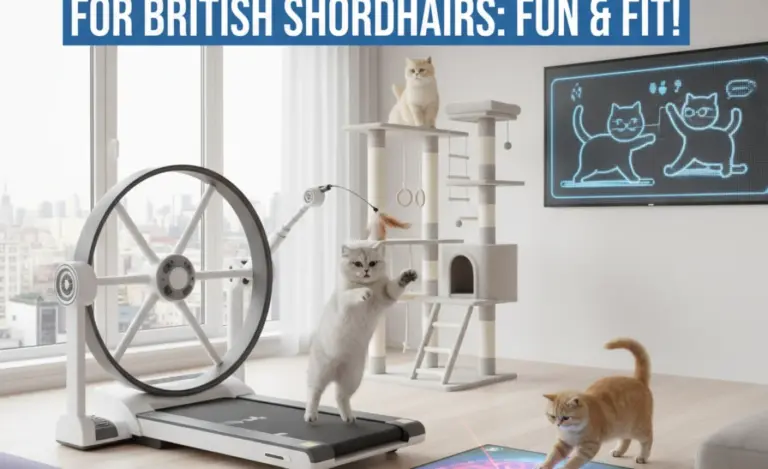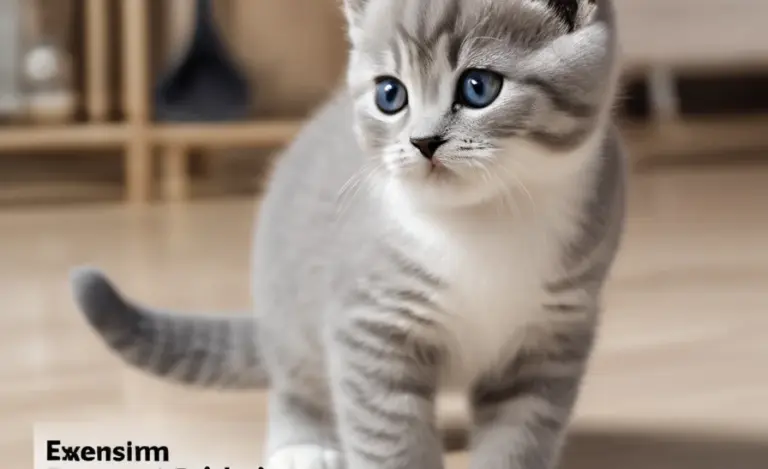Indoor Climbing Games for British Shorthairs: Fun!
Do you have a British Shorthair cat? Do you want to keep them happy and active? Indoor climbing games for British Shorthairs can be a great way to do this. Cats love to climb and explore. These games give them a safe way to do it inside.
Have you ever seen a cat jump on top of a bookshelf? Or maybe climb up the curtains? Cats are natural climbers. They like to be up high where they can see everything. Indoor climbing games can help them satisfy this need. They also help them get exercise. This is very important for indoor cats.
What if your cat could climb and play all day long, indoors? It sounds fun, right? There are many different types of climbing games you can get for your British Shorthair. These games can keep them entertained and healthy. Let’s explore some fun options!
Key Takeaways
- Indoor climbing games for British Shorthairs provide essential exercise and mental stimulation.
- Cat trees and shelves offer vertical space, satisfying a cat’s natural instincts.
- Rotate toys to keep your British Shorthair engaged and prevent boredom.
- Safety is key: ensure climbing structures are stable and secure.
- Observe your cat’s preferences to choose the most suitable climbing games.
Why Indoor Climbing Games For Cats Matter
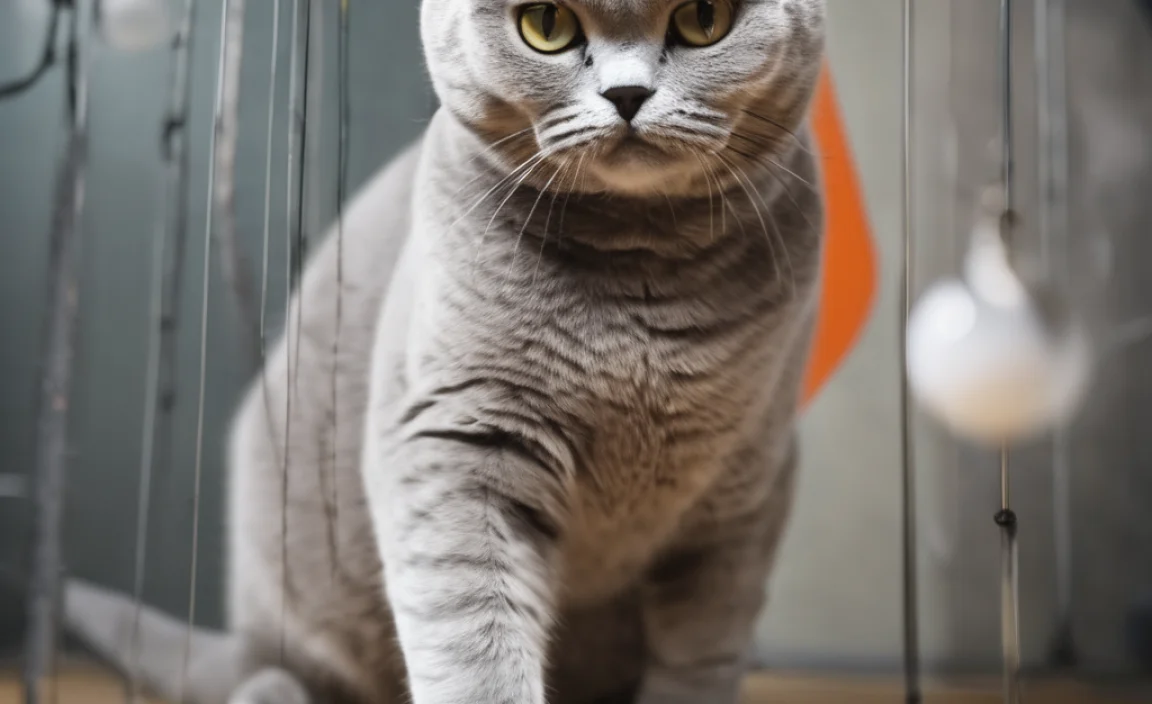
Cats are natural climbers. It is in their DNA. Climbing helps them explore their surroundings. It also gives them a sense of security. High places let them watch the world below. For a British Shorthair, climbing is more than just fun. It’s a way to stay physically and mentally healthy. Indoor climbing games mimic their natural environment. This keeps them happy and reduces stress. Without climbing opportunities, cats can become bored. Boredom can lead to destructive behaviors. They might scratch furniture or become aggressive. Providing climbing structures gives them an outlet for their energy. This keeps them happy and your home safe. A good climbing setup encourages exercise. This helps maintain a healthy weight. Obesity is a common problem in indoor cats. Climbing helps them stay fit and active. It also strengthens their muscles and improves their coordination. Investing in indoor climbing games is an investment in your cat’s overall well-being.
- Climbing satisfies natural instincts.
- It provides exercise and mental stimulation.
- Climbing reduces boredom and stress.
- It helps maintain a healthy weight.
- Climbing strengthens muscles and improves coordination.
Climbing is not just about physical activity. It also provides mental stimulation. When cats climb, they are problem-solving. They are figuring out how to get from one point to another. This challenges their minds and keeps them engaged. Indoor climbing games can be customized to suit your cat’s personality. Some cats prefer tall, challenging climbs. Others prefer lower, more accessible structures. Observe your cat’s behavior to see what they enjoy. You can then choose climbing games that match their preferences. This will make them even more likely to use and enjoy the games. Remember, a happy cat makes a happy home. Providing them with climbing opportunities is a simple way to improve their quality of life.
What Are the Benefits of Climbing?
Have you ever wondered why cats love to be up high? Climbing provides them with a sense of security. It allows them to survey their territory. This behavior is deeply rooted in their instincts. In the wild, cats climb trees to escape predators. They also climb to find a good vantage point for hunting. Indoor climbing games allow domestic cats to express these natural behaviors. Climbing is also a great form of exercise. It helps cats burn calories and maintain a healthy weight. This is especially important for indoor cats. They do not have as many opportunities to exercise as outdoor cats. Climbing strengthens their muscles and improves their coordination. It also provides mental stimulation. Cats have to think about how to get from one point to another. This challenges their minds and keeps them engaged. Providing climbing opportunities is a simple way to improve your cat’s overall well-being.
How Does Climbing Reduce Stress?
Imagine you’re a cat stuck inside all day. You have no trees to climb and no mice to chase. Sounds boring, right? This is why indoor climbing games are so important. Climbing helps cats relieve stress and anxiety. When cats are stressed, they often seek out high places. This allows them to feel safe and in control. Climbing also releases endorphins. These are natural chemicals that have mood-boosting effects. Providing climbing structures gives cats a healthy way to cope with stress. It also prevents them from developing destructive behaviors. A stressed cat might scratch furniture or become aggressive. Climbing can help them release their pent-up energy in a positive way. It also provides mental stimulation. This can distract them from whatever is causing them stress. A happy, relaxed cat is a joy to be around. Climbing can help you create a more peaceful and harmonious home.
Why Is Climbing Important for British Shorthairs?
British Shorthairs are known for their calm and gentle nature. But they still need exercise and mental stimulation. Indoor climbing games are a great way to provide this. These cats can become overweight if they don’t get enough exercise. Climbing helps them burn calories and maintain a healthy weight. It also strengthens their muscles and improves their coordination. Climbing is not just about physical health. It also provides mental enrichment. British Shorthairs are intelligent cats. They need to be challenged and engaged. Climbing provides them with a problem-solving activity. They have to figure out how to get from one point to another. This keeps their minds sharp and prevents boredom. Providing climbing opportunities is a simple way to keep your British Shorthair happy and healthy. It also helps them express their natural instincts.
Fun Fact or Stat: A study found that cats with access to climbing structures are less likely to exhibit destructive behaviors like scratching furniture.
Choosing the Right Cat Tree for Your Cat

A cat tree is a great investment for your British Shorthair. But with so many options, how do you choose the right one? First, consider the size of your cat. British Shorthairs are medium to large cats. They need a sturdy tree that can support their weight. Look for a tree with a wide base to prevent tipping. The height of the tree is also important. Most cats enjoy climbing high. Choose a tree that is tall enough to satisfy their climbing instincts. But make sure it is not so tall that it is unstable. Think about the materials used to make the tree. Sisal rope is a good choice for scratching posts. It is durable and provides a good texture for cats to scratch. Plush fabric is soft and comfortable for cats to sleep on. Make sure the fabric is easy to clean. Consider the features of the tree. Some trees have multiple levels, hiding places, and dangling toys. Choose a tree that has features that your cat will enjoy. Introduce the tree to your cat slowly. Place it in a location where they spend a lot of time. Use treats and toys to encourage them to explore the tree. With a little patience, your cat will soon be enjoying their new climbing structure.
- Consider your cat’s size and weight.
- Choose a sturdy tree with a wide base.
- Look for sisal rope scratching posts.
- Choose plush fabric for comfort.
- Consider the features of the tree.
- Introduce the tree to your cat slowly.
The design of the cat tree is also important. Some trees are designed to look like trees. Others are more modern and minimalist. Choose a design that complements your home decor. But remember, the most important thing is that your cat enjoys the tree. Don’t be afraid to experiment with different types of trees. You might be surprised at what your cat prefers. Some cats prefer tall, skinny trees. Others prefer short, wide trees. The best way to find out is to try different options. You can also ask your vet for recommendations. They might have experience with different types of cat trees. Remember, a cat tree is an investment in your cat’s health and happiness. It provides them with exercise, mental stimulation, and a safe place to relax. Choosing the right tree is a simple way to improve your cat’s quality of life. It also helps protect your furniture from scratching.
What Size Cat Tree Should I Get?
Are you wondering what size cat tree to buy? The size of your cat is the most important factor. British Shorthairs are medium to large cats. They need a tree that can support their weight. Choose a tree with a wide base to prevent tipping. The height of the tree is also important. Most cats enjoy climbing high. Choose a tree that is tall enough to satisfy their climbing instincts. But make sure it is not so tall that it is unstable. Measure the space where you plan to put the tree. Make sure the tree will fit comfortably in the space. You don’t want it to be too crowded or overwhelming. Consider the number of cats you have. If you have multiple cats, you might need a larger tree. This will give them all enough space to climb and play. Don’t be afraid to ask for help. Your local pet store can help you choose the right size tree for your cat.
What Materials Should I Look For?
Have you ever wondered what cat trees are made of? The materials used to make a cat tree are important. They determine its durability and safety. Sisal rope is a good choice for scratching posts. It is durable and provides a good texture for cats to scratch. Plush fabric is soft and comfortable for cats to sleep on. Make sure the fabric is easy to clean. Wood is a common material for the frame of the tree. Choose a tree made from sturdy wood. This will ensure that it can support your cat’s weight. Avoid trees made from cheap materials. These trees are more likely to break or tip over. Look for trees that are made from non-toxic materials. This is especially important if your cat likes to chew on things. A good quality cat tree will last for many years. It is worth investing in a tree made from durable and safe materials.
How Can I Introduce My Cat to the Tree?
So, you bought a new cat tree. Now, how do you get your cat to use it? Introducing your cat to the tree slowly is important. Place the tree in a location where they spend a lot of time. This will help them get used to it. Use treats and toys to encourage them to explore the tree. Place treats on different levels of the tree. This will encourage them to climb and explore. You can also dangle toys from the tree. This will encourage them to play and interact with it. Be patient. It might take some time for your cat to get used to the tree. Don’t force them to use it. Let them explore it at their own pace. Once they start using it, praise them and give them treats. This will reinforce their positive behavior. With a little patience, your cat will soon be enjoying their new climbing structure.
Fun Fact or Stat: Cats are more likely to use a cat tree if it is placed near a window or in a high-traffic area of the home.
DIY Indoor Climbing Games for British Shorthairs
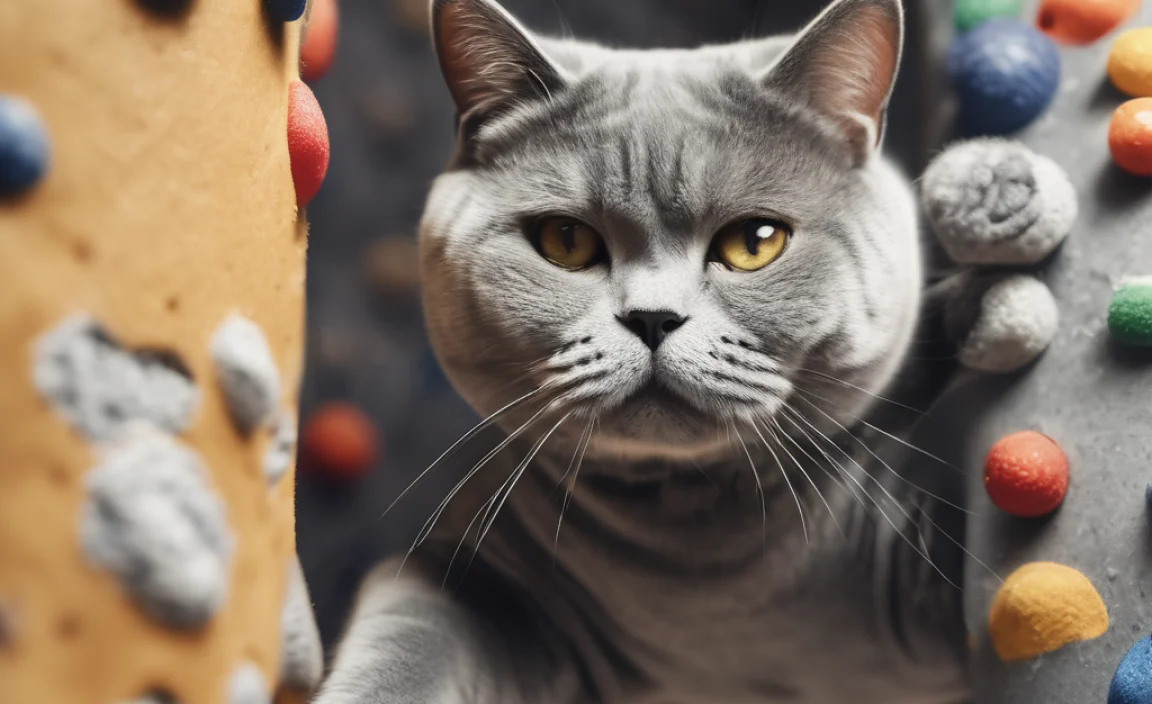
Want to save money? You can create your own indoor climbing games for British Shorthairs. DIY projects can be fun and rewarding. They also allow you to customize the games to your cat’s specific needs. One simple project is to create a wall-mounted climbing shelf. You can use wooden planks and brackets to create a series of shelves. Arrange the shelves at different heights. This will create a climbing pathway for your cat. Make sure the shelves are securely attached to the wall. You don’t want them to fall down while your cat is climbing. Another easy project is to create a cardboard box fort. Collect several cardboard boxes of different sizes. Cut holes in the boxes. This will allow your cat to climb in and out. Stack the boxes on top of each other. Secure them with tape or glue. You can also add toys and treats inside the boxes. This will make the fort even more appealing to your cat. Get creative and have fun. DIY climbing games are a great way to keep your cat entertained and active.
- Create wall-mounted climbing shelves.
- Build a cardboard box fort.
- Use PVC pipes to create a climbing structure.
- Repurpose old furniture into climbing games.
- Make a window perch for your cat.
Safety is important when creating DIY climbing games. Make sure all materials are non-toxic. Avoid using sharp objects or small parts that your cat could swallow. Test the stability of the games before letting your cat use them. You don’t want them to fall down and get hurt. Supervise your cat while they are using the games. This will allow you to identify any potential hazards. DIY climbing games are a great way to bond with your cat. They also provide them with exercise and mental stimulation. With a little creativity, you can create a fun and engaging environment for your furry friend. Remember to involve your cat in the process. Let them sniff and explore the materials you are using. This will help them feel more comfortable with the games. They may even have some ideas of their own!
How Can I Build a Wall-Mounted Shelf?
Do you want to build a wall-mounted shelf for your cat? It is a simple and rewarding project. First, gather your materials. You will need wooden planks, brackets, screws, and a drill. Choose wooden planks that are sturdy and non-toxic. The size of the planks will depend on the size of your cat. Measure the space where you want to install the shelves. This will help you determine the number of shelves you need. Attach the brackets to the wall using screws. Make sure the brackets are securely attached. You don’t want the shelves to fall down. Attach the wooden planks to the brackets using screws. Make sure the planks are level. You can use a level to ensure that they are straight. Test the stability of the shelves before letting your cat use them. You can do this by gently pushing on them. If they feel wobbly, tighten the screws. With a little effort, you can create a fun and engaging climbing structure for your cat.
What Can I Do With Cardboard Boxes?
Have you ever thought about using cardboard boxes for cat toys? Cardboard boxes are a great resource for DIY climbing games. They are cheap, readily available, and easy to work with. Collect several cardboard boxes of different sizes. Cut holes in the boxes. This will allow your cat to climb in and out. Stack the boxes on top of each other. Secure them with tape or glue. You can also add toys and treats inside the boxes. This will make the fort even more appealing to your cat. Get creative and have fun. You can decorate the boxes with paint or markers. You can also add fabric scraps or yarn. This will make the fort more visually appealing. Cardboard boxes are a great way to recycle and reuse materials. They also provide your cat with hours of entertainment.
What About PVC Pipe Structures?
PVC pipes are another great material for DIY climbing games. They are lightweight, durable, and easy to work with. You can use PVC pipes to create a variety of climbing structures. One popular project is to build a cat tree. You can use PVC pipes to create the frame of the tree. Then, cover the frame with carpet or fabric. You can also add scratching posts and toys. Another idea is to create a climbing wall. You can attach PVC pipes to a wall using brackets. This will create a climbing pathway for your cat. Make sure the pipes are securely attached to the wall. You don’t want them to fall down while your cat is climbing. PVC pipes are a versatile material. They can be used to create a variety of climbing games. With a little creativity, you can create a fun and engaging environment for your furry friend.
Fun Fact or Stat: DIY cat toys and climbing structures can save you money and provide your cat with unique and engaging play experiences.
Incorporating Scratching Posts In Climbing Games

Scratching is a natural behavior for cats. It helps them maintain their claws. It also allows them to mark their territory. Providing scratching posts is essential for your cat’s well-being. You can incorporate scratching posts into indoor climbing games for British Shorthairs. This will encourage them to scratch in appropriate places. Look for cat trees that have built-in scratching posts. These posts are usually covered in sisal rope. Sisal rope is a durable material that cats love to scratch. You can also add separate scratching posts to your climbing setup. Place the posts near the climbing structures. This will encourage your cat to use them. You can also sprinkle catnip on the posts. This will make them even more appealing. Experiment with different types of scratching posts. Some cats prefer vertical posts. Others prefer horizontal posts. Observe your cat’s behavior to see what they prefer. Providing scratching posts is a simple way to keep your cat happy and healthy. It also helps protect your furniture from scratching.
- Look for cat trees with built-in scratching posts.
- Add separate scratching posts to your climbing setup.
- Sprinkle catnip on the scratching posts.
- Experiment with different types of scratching posts.
- Place scratching posts near climbing structures.
The location of the scratching posts is important. Place them in areas where your cat likes to scratch. This might be near their favorite sleeping spot. Or it might be near a window. You can also place them near doorways. Cats often scratch after waking up or before going outside. Make sure the scratching posts are sturdy and stable. You don’t want them to tip over while your cat is using them. You can also try different materials for the scratching posts. Some cats prefer cardboard. Others prefer carpet. You can even make your own scratching posts. Simply wrap a piece of wood in sisal rope. Secure the rope with glue or staples. Providing scratching posts is an essential part of cat ownership. It helps keep your cat’s claws healthy. It also helps protect your furniture from damage. By incorporating scratching posts into indoor climbing games, you can create a fun and engaging environment for your cat.
Why Do Cats Need Scratching Posts?
Have you ever wondered why cats scratch? Scratching is a natural and important behavior for cats. It serves several purposes. First, it helps them maintain their claws. Scratching removes the dead outer layer of the claw. This keeps their claws sharp and healthy. Second, scratching allows cats to mark their territory. They have scent glands in their paws. When they scratch, they leave behind a scent that other cats can detect. This scent marks their territory and warns other cats to stay away. Third, scratching is a form of exercise. It stretches their muscles and helps them stay in shape. Providing scratching posts allows cats to express these natural behaviors in a safe and appropriate way. Without scratching posts, cats may resort to scratching furniture or carpets. This can be frustrating for owners. Providing scratching posts is a simple way to prevent this problem.
What Types of Scratching Posts Are Best?
Are you wondering what type of scratching post to get? There are many different types of scratching posts available. Some are vertical, while others are horizontal. Some are made of sisal rope, while others are made of cardboard or carpet. The best type of scratching post for your cat will depend on their individual preferences. Observe your cat’s scratching behavior. Do they prefer to scratch vertically or horizontally? Do they prefer sisal rope, cardboard, or carpet? You can also try offering your cat a variety of scratching posts. This will allow them to choose the one they prefer. Some cats prefer vertical posts because they allow them to stretch their bodies. Other cats prefer horizontal posts because they are easier to access. Experiment with different types of posts to see what your cat likes best.
How Do I Encourage My Cat To Use Them?
So, you bought a scratching post. How do you get your cat to use it? Introducing your cat to the scratching post slowly is important. Place the post in a location where they spend a lot of time. This will help them get used to it. Sprinkle catnip on the post. This will make it more appealing. You can also rub your cat’s scent on the post. This will help them recognize it as their own. Encourage your cat to scratch the post by gently guiding their paws. You can also use a toy to entice them to scratch. Be patient. It may take some time for your cat to start using the post regularly. Don’t force them to use it. Let them explore it at their own pace. Once they start using it, praise them and give them treats. This will reinforce their positive behavior. With a little patience, your cat will soon be enjoying their new scratching post.
Fun Fact or Stat: Cats have scent glands in their paws that release a unique scent when they scratch, marking their territory.
Safety Tips for Indoor Climbing Games
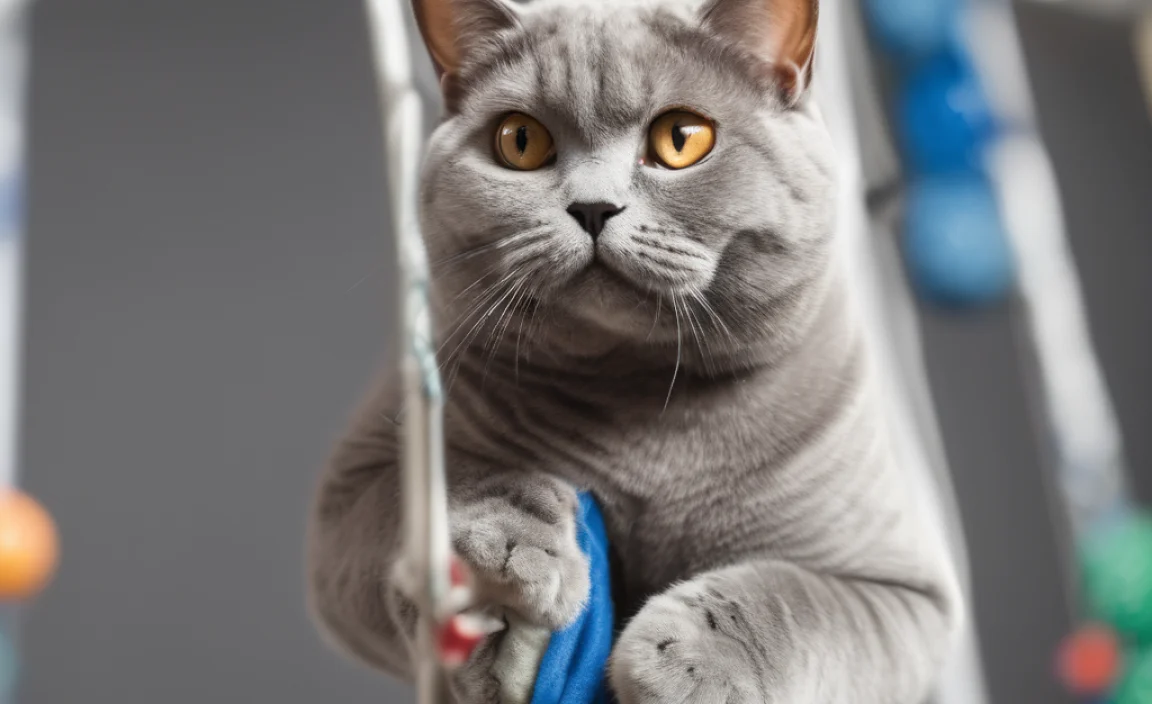
Safety is important when setting up indoor climbing games for British Shorthairs. You want to make sure your cat is safe and secure while they are playing. Inspect the climbing structures regularly. Look for any loose parts or damage. Repair or replace any damaged structures immediately. Make sure the structures are stable and secure. You don’t want them to tip over while your cat is climbing. Place the structures in a safe location. Avoid placing them near windows or other hazards. Consider using non-slip surfaces. This will help your cat grip the structures more easily. Supervise your cat while they are using the climbing games. This will allow you to identify any potential hazards. Start slowly. Don’t introduce too many climbing structures at once. This can overwhelm your cat. Gradually introduce new structures as they become more comfortable. With a little planning, you can create a safe and fun climbing environment for your furry friend.
- Inspect climbing structures regularly for damage.
- Ensure structures are stable and secure.
- Place structures in a safe location.
- Use non-slip surfaces for better grip.
- Supervise your cat during playtime.
- Introduce new structures gradually.
The height of the climbing structures is important. Don’t make them too tall. This can increase the risk of falls. If your cat is not used to climbing, start with lower structures. Gradually increase the height as they become more confident. Consider your cat’s age and physical condition. Older cats or cats with health problems may not be able to climb as high. Adjust the climbing setup to suit their needs. Make sure the area around the climbing structures is clear. Remove any obstacles that could cause your cat to trip or fall. You can also place soft landing pads around the structures. This will cushion any falls. Remember, safety is always the top priority. By following these tips, you can create a safe and enjoyable climbing environment for your cat. This will help them stay active and healthy.
What Makes a Climbing Structure Safe?
Have you ever thought about what makes a climbing structure safe for a cat? The stability of the structure is the most important factor. It should be able to support your cat’s weight without tipping over. Choose a structure with a wide base. This will make it more stable. The materials used to make the structure are also important. Avoid structures made from cheap or flimsy materials. These structures are more likely to break or collapse. Look for structures made from sturdy wood or metal. The design of the structure should also be considered. Avoid structures with sharp edges or protruding parts. These can pose a hazard to your cat. The climbing surfaces should be non-slip. This will help your cat grip the structure more easily. A safe climbing structure will provide your cat with hours of fun and exercise.
How High Is Too High for a Cat Tree?
Are you wondering how tall a cat tree should be? The height of the cat tree is important. It should be tall enough to satisfy your cat’s climbing instincts. But it should not be so tall that it is unsafe. A good rule of thumb is to choose a cat tree that is no more than twice your cat’s height. For example, if your cat is 12 inches tall, the cat tree should be no more than 24 inches tall. Consider your cat’s age and physical condition. Older cats or cats with health problems may not be able to climb as high. Adjust the height of the cat tree to suit their needs. Make sure the cat tree is stable and secure. You don’t want it to tip over while your cat is climbing. A cat tree that is too tall can be dangerous for your cat.
What If My Cat Is Scared To Climb?
So, you bought a cat tree. But your cat is afraid to climb it. What can you do? Be patient. It may take some time for your cat to get used to the tree. Don’t force them to climb. Let them explore it at their own pace. Place treats on different levels of the tree. This will encourage them to climb. You can also dangle toys from the tree. This will encourage them to play and interact with it. Make sure the tree is stable and secure. A wobbly tree can be scary for cats. You can also try using catnip. Sprinkle catnip on the tree. This will make it more appealing. With a little patience, your cat will overcome their fear and start enjoying their new climbing structure.
Fun Fact or Stat: Placing a soft landing pad around climbing structures can help prevent injuries from falls.
Rotating Toys and Games for Engagement
Cats can get bored easily. It is important to keep their environment stimulating. Rotating toys and games is a great way to do this. It keeps them engaged and prevents boredom. When it comes to indoor climbing games for British Shorthairs, variety is key. Don’t leave the same toys out all the time. Instead, rotate them regularly. This will make them seem new and exciting. Choose a variety of toys. Some cats like toys that they can chase. Others prefer toys that they can bat around. Experiment with different types of toys to see what your cat enjoys. You can also create your own toys. A simple toy can be made from a cardboard box and some string. This will provide your cat with hours of entertainment. Rotating toys and games is a simple way to keep your cat happy and active. It also helps prevent destructive behaviors.
- Rotate toys regularly to keep them exciting.
- Choose a variety of toys to suit different preferences.
- Create your own toys using simple materials.
- Hide toys around the climbing structures for your cat to find.
- Use interactive toys that require your cat to problem-solve.
The frequency of toy rotation depends on your cat. Some cats need their toys rotated daily. Others are happy with a weekly rotation. Observe your cat’s behavior. If they seem bored with their toys, it’s time to rotate them. When you rotate the toys, put away the old ones. This will make the new toys seem even more exciting. You can also hide toys around the climbing structures. This will encourage your cat to explore and climb. Interactive toys are a great way to keep your cat mentally stimulated. These toys require your cat to problem-solve in order to get a treat. This keeps their minds sharp and prevents boredom. Rotating toys and games is an essential part of cat ownership. It helps keep your cat happy, healthy, and engaged. It also strengthens the bond between you and your furry friend.
Why Is Toy Rotation Important?
Have you ever wondered why toy rotation is important for cats? Cats are creatures of habit. But they can also get bored easily. Toy rotation helps prevent boredom. It keeps their environment stimulating. When cats are bored, they may become destructive. They may start scratching furniture or chewing on things they shouldn’t. Toy rotation provides them with a positive outlet for their energy. It also keeps their minds engaged. A bored cat is an unhappy cat. Toy rotation is a simple way to improve your cat’s quality of life. It also helps protect your home from damage.
What Kinds of Toys Should I Rotate?
Are you wondering what kinds of toys to rotate? Choose a variety of toys. This will keep your cat interested. Some cats like toys that they can chase. Others prefer toys that they can bat around. Experiment with different types of toys to see what your cat enjoys. Feather wands are a popular choice. They mimic the movement of birds. This can be very enticing for cats. Laser pointers are another popular option. But be careful not to shine the laser in your cat’s eyes. Puzzle toys are a great way to keep your cat mentally stimulated. These toys require your cat to problem-solve in order to get a treat. Rotate the toys regularly. This will keep them seeming new and exciting.
How Often Should I Rotate the Toys?
So, you have a collection of toys. How often should you rotate them? The frequency of toy rotation depends on your cat. Some cats need their toys rotated daily. Others are happy with a weekly rotation. Observe your cat’s behavior. If they seem bored with their toys, it’s time to rotate them. When you rotate the toys, put away the old ones. This will make the new toys seem even more exciting. You can also try hiding the toys. This will encourage your cat to search for them. Toy rotation is a simple way to keep your cat happy and engaged.
Fun Fact or Stat: Rotating toys can increase a cat’s interest in playing by up to 50%.
Considerations for Older British Shorthairs
Older British Shorthairs may have different needs when it comes to indoor climbing games. As they age, they may develop arthritis or other health problems. This can make it difficult for them to climb. It is important to adjust the climbing setup to suit their needs. Lower the height of the climbing structures. This will make it easier for them to access. Provide ramps or steps. This will help them get to higher levels. Use non-slip surfaces. This will give them better grip. Make sure the climbing structures are stable and secure. You don’t want them to fall down while your cat is climbing. Consider their comfort. Provide soft bedding on the climbing structures. This will make them more comfortable. Older cats still need exercise and mental stimulation. Climbing can provide both. But it is important to make sure they are safe and comfortable. With a little planning, you can create a climbing environment that is suitable for your senior cat.
- Lower the height of climbing structures.
- Provide ramps or steps for easier access.
- Use non-slip surfaces for better grip.
- Ensure structures are stable and secure.
- Provide soft bedding for comfort.
The type of climbing structures you choose is also important. Avoid structures with small or narrow openings. These can be difficult for older cats to navigate. Choose structures with wide, open spaces. This will make it easier for them to move around. Consider their vision. Older cats may have impaired vision. Make sure the climbing structures are well-lit. This will help them see better. You can also use contrasting colors. This will make it easier for them to distinguish the different levels. Be patient. It may take some time for your older cat to adjust to the new climbing setup. Don’t force them to climb. Let them explore it at their own pace. With a little patience and understanding, you can help your senior cat stay active and engaged. This will improve their quality of life and strengthen the bond between you and your furry friend.
What Are the Physical Limitations of Older Cats?
Have you ever wondered about the physical limitations of older cats? As cats age, they may develop a variety of health problems. These problems can affect their ability to climb and play. Arthritis is a common problem in older cats. It can cause pain and stiffness in their joints. This can make it difficult for them to jump and climb. Vision problems are also common in older cats. They may develop cataracts or glaucoma. This can make it difficult for them to see. Muscle weakness is another common problem. This can make it difficult for them to support their weight. It is important to be aware of these physical limitations when setting up indoor climbing games for older cats. Adjust the climbing setup to suit their needs.
How Can I Modify Climbing Games for Senior Cats?
So, you want to modify climbing games for your senior cat. Here’s how. Lower the height of the climbing structures. This will make it easier for them to access. Provide ramps or steps. This will help them get to higher levels. Use non-slip surfaces. This will give them better grip. Make sure the climbing structures are stable and secure. You don’t want them to fall down while your cat is climbing. Consider their comfort. Provide soft bedding on the climbing structures. This will make them more comfortable. You can also try using a laser pointer. This will encourage them to move around. Be careful not to shine the laser in their eyes. With a little creativity, you can create a fun and engaging climbing environment for your senior cat.
What Kind of Vet Advice Should I Consider?
Before setting up indoor climbing games for your senior cat, talk to your vet. Your vet can provide valuable advice about your cat’s health and physical condition. They can also help you identify any potential risks. Ask your vet about any specific limitations your cat may have. They can also recommend modifications to the climbing setup. Your vet may also recommend certain supplements or medications. These can help improve your cat’s joint health and mobility. It is important to follow your vet’s advice. This will help ensure that your senior cat is safe and comfortable. A vet can also advise on weight management, ensuring your cat isn’t carrying extra weight that would make climbing even more difficult.
Fun Fact or Stat: Over 50% of cats over the age of 10 suffer from arthritis, making modifications to climbing games essential.
Comparing Different Climbing Game Options
Choosing the right climbing game can be tricky. There are many options. Cat trees, wall-mounted shelves, and DIY structures. Each has pros and cons. Consider your cat’s personality. Also consider your space and budget. Indoor climbing games for British Shorthairs need careful planning. Cat trees are popular. They offer multiple levels. Some have scratching posts. Others have hiding places. Wall-mounted shelves save space. They allow custom layouts. DIY structures are budget-friendly. They allow creative design. Safety is key. Ensure structures are stable. Check for sharp edges. Supervise your cat during play. Here’s a table to help you decide:
| Climbing Game | Pros | Cons | Best For |
|---|---|---|---|
| Cat Trees | Multiple levels, scratching posts, hiding places | Can be bulky, may not fit all spaces | Cats that love to climb and scratch |
| Wall-Mounted Shelves | Space-saving, customizable layouts | Requires installation, may not be as stable | Small spaces, cats that enjoy exploring |
| DIY Structures | Budget-friendly, creative designs | Requires time and effort, safety concerns | Creative owners, budget-conscious families |
| Window Perches | Provides a view, easy to install | Limited climbing, may not be suitable for all windows | Cats that love to watch the outside world |
- Cat trees offer variety but can be bulky.
- Wall-mounted shelves save space and customize.
- DIY structures are budget-friendly and creative.
- Consider your cat’s personality and preferences.
- Safety is always the top priority.
Think about your cat’s climbing style. Some cats like height. Others prefer exploring. Cat trees suit climbers. Wall shelves suit explorers. DIY options let you mix and match. Older cats need low, accessible options. Young cats need challenging climbs. Observe your cat’s habits. This helps pick the best games. British Shorthairs often enjoy sturdy, stable setups. They may prefer plush surfaces. Consider their weight and size


